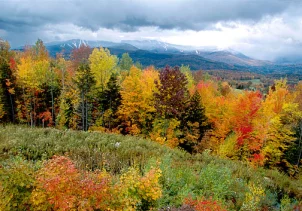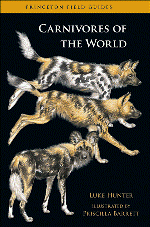Wild Tracks
On behalf of the world's wild species
Temperate Forest Ecosystem
 One-quarter of the remaining global temperate forests can be found on the British Columbia coast of Canada. The other remnants can be found in eastern United States, Europe, Russia, southwest South America, New Zealand, Australia, China and Japan. Almost all the temperate forests are located near an ocean.
One-quarter of the remaining global temperate forests can be found on the British Columbia coast of Canada. The other remnants can be found in eastern United States, Europe, Russia, southwest South America, New Zealand, Australia, China and Japan. Almost all the temperate forests are located near an ocean.
Some common naturally-occurring temperate forest foods include walnuts, chestnuts, apples, mushrooms and maple sugar. In many areas the original temperate forests have been cleared for farming, but one important protected area is the Great Smoky Mountains, which has been designated a World Biosphere Reserve.
This type of forest lies between the Polar Regions and the tropics, where there are four distinct seasons, and is comprised primarily of trees that annually lose their leaves as cold weather approaches (deciduous). As the hours of daylight shorten in the fall season, the trees remove chlorophyll from the leaves, providing us with a spectacular range of colour before they fall to the ground. The leaves then decompose to provide rich nutrients, creating a very fertile soil and making it an appealing area to carry on agricultural pursuits; consequently, much of this biome has been converted to farmland.
Because of its reasonably amenable climate (averaging 21ºC in summer and just below freezing in winter) and an even distribution of rainfall (36cm. to 46 cm.), a large majority of humans has chosen to live in this region.
Temperate forests are home to a huge variety of species:
Mammals – giant pandas, bears, raccoons, squirrels, skunks, deer, timber wolves, cougars, beaver, muskrats, koalas, wallabies
Birds – bald eagles, woodpeckers, chickadees, warblers, wrens, thrushes, and hummingbirds
Invertebrates – mosquitoes, gnats, black flies, butterflies, scorpions, grasshoppers, ants
Reptiles – rattlesnakes, corn snakes, rat snake
Amphibians – leopard frogs, bullfrogs, newts, salamanders
Animal Adaptations
Because of the relatively harsh winters and scarce food supplies, many animals migrate to warmer climates during the fall. For example, many Canadian songbirds fly south in the fall, returning in the spring.
The cold winter temperatures mean that most animals reproduce seasonally, during the spring and summer, not year round.
Some mammals such as bears and mice dig out a den or burrow, lowering their metabolism and sleep during the cold months, living off their fat reserves and emerging in the spring. Snakes and terrestrial frogs also dig out a burrow, or hibernaculum during the cold weather.
Newts and salamanders depend upon entering into a state of dormancy during the winter in order to develop sexual characteristics.
Snakes and terrestrial frogs also dig out a burrow, or hibernaculum during the cold weather. Aquatic frogs tend to burrow down into the mud of rivers and ponds and enter a state of dormancy. Frogs have the ability to produce a large quantity of glucose to prevent their organs from freezing.
Camouflage allows animals to blend in with their environment, thus affording some protection from predators. For example, the stomach area of some tree squirrels is lighter than their backs (countershading), allowing them to blend into the branches of trees or ground as the sun filters through. Likewise, the eastern gray squirrel has brown fur in on its sides and back during summer and much lighter gray fur in winter.
Some animals such as chipmunks build a series of complex burrows and spend the winter there, surviving on the storage of nuts, seeds, etc. collected during the time of plenty in summer and fall. It is thought that they hibernate once their food supply has been used up.
Animals such as bats and opossums have adapted to be active during the night, to reduce the possibility of being found by predators.
Plant Adaptations
There are three main groups of trees found in temperate forests.
1./Deciduous trees lose their leaves annually in the fall, as the days get shorter and the weather changes.
These trees utilize their broad, flat leaves to collect sunlight spreading out as they grow, but they need warmth and moisture to survive. They take advantage of the three mild seasons and stop growing during the winter when food is not available. Deciduous trees generally have a thick bark to protect them during the cold winter months.
Most deciduous trees bear fruit or seed that is protected by a hard outer shell, making it difficult for animals and birds to eat them. The seeds are indigestible and pass through the animal’s droppings intact; in this way, animals are a vital ingredient to dispersing seeds far away from the parent tree, where it can potentially grow in a sunny area.
2./Coniferous trees have needles which gradually drop off at staggered times so that the tree remains green all year round. These trees tend to grow straight upward, forming a triangular shape, rather than spreading out. Their leaves are either long and needle-shaped or small and scaly. Cones contain seeds which disperse as the cone opens its scales.
3./Broad-leaved Evergreens do not lose their flat, leathery leaves in winter. Instead, a waxy substance provides enough moisture to prevent the leaves from drying up.
These Evergreens vary from bearing cones to having leaves, depending upon the amount of warmth and rainfall year-round, such as laurels, acacias, sumacs and eucalyptus.
Layers in the temperate deciduous forests:
Forest Canopy Tier – This is the topmost layer where trees such as maple, oak, walnut, sweetgum, linden and birch grow upwards of 60-100 feet
Small Tree Tier – In this layer younger specimens of the tall trees, dogwood, redbuds and shadbush are examples of this layer
Shrub Tier – Examples of vegetation in this layer include azaleas, mountain laurel, huckleberries and rhododendron
Herb Tier – In this layer you will find perennials that bloom primarily in the spring, such as wildflowers, berries, blue bead lily, Indian cucumber and wild sarsaparilla
Ground Tier – Ground-hugging plants such as lichens and mosses thrive in this layer. Lianas such as wild grape, poison ivy and Virginia creeper take advantage of nearby trees to spread their vines upwards to flower and fruit.
Effects of Global Warming on Temperate Forests
- Forests are a vital part of the ecosystem in transforming carbon dioxide into essential oxygen. They also cool the Earth’s overall temperatures by providing shade. We are experiencing clear global warming as a result of the loss of trees.
- It is said that just one tree can evaporate thousands of litres of water into the atmosphere, and consequently affect the amount of rainfall in that area.
- Temperate forests have been cleared for agriculture and also to provide timber for houses, furniture and ships. Temperate forest trees are also clear-cut to make paper and other products. As we continue to lose temperate forests in this manner, the nutrients in the soil disappear, causing erosion and can even turn once-fertile land into desert.
- We know that air pollution is a by-product of factories, coal-burning power plants, cars, etc. and that when mixed with rainfall the result is acid rain. Acid rain destroys plants. So, we lose forests not only from logging but also from pollution.
- The endangered spotted owl is but one species on the point of extinction due to clear-cutting of its habitat in western North America. Only approximately 20% of its original home in old growth forests in British Columbia is left. Although the focus has been on the Northern Spotted owl, it is estimated that approximately 4 species of amphibians, 34 species of birds, 17 species of mammals and 16 species of fish share the owl’s habitat and are rapidly declining in numbers.
- We depend upon trees for our very survival, and we are paying the price for ignoring the very obvious signs of global warming and acid rain as a result of continuing to clear-cut our forests.

You must be logged in to post a comment.